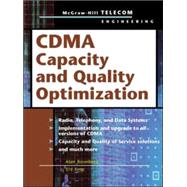
What is included with this book?
Sid Kemp is an expert in architecture, standards, quality management, and organizational structure for information technology and telecommunications. As president of Quality Technology & Instruction (QTI), he provides clients with consulting and training that increase quality of service especially by improving teamwork between technical engineers and business experts and executives. He appreciates comments on his writing and can be reached at sid@qualitytechnology.com. For updates and additional information about this book, see his corporate Web site, www.qualitytechnology.com/qti/cdma.
The New copy of this book will include any supplemental materials advertised. Please check the title of the book to determine if it should include any access cards, study guides, lab manuals, CDs, etc.
The Used, Rental and eBook copies of this book are not guaranteed to include any supplemental materials. Typically, only the book itself is included. This is true even if the title states it includes any access cards, study guides, lab manuals, CDs, etc.